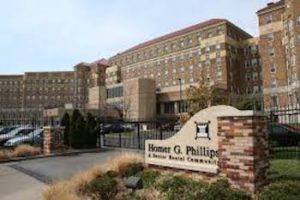
Homer G. Phillips Hospital
*Homer G. Phillips Hospital is celebrated on this date in 1937. It was the first and only hospital for Blacks in St. Louis, Missouri.
Located at 2601 N. Whittier Street in The Ville neighborhood, it was the first teaching hospital west of the Mississippi River to serve Blacks. Between 1910 and 1920, the Black population of St. Louis increased by sixty percent as rural migrants came North in the Great Migration to take industrial jobs.
At the time, the public City Hospital served only whites. In 1919, a group of Black community leaders persuaded the city to purchase a 177-bed hospital (formerly owned by Barnes Medical College) at Garrison and Lawson avenues on the city's north side to serve Blacks. This hospital, designated as City Hospital #2, was inadequate to the needs of the more than 70,000 Black St. Louis citizens.
Local Black attorney Homer G. Phillips led a campaign for a civic improvements bond issue to construct a larger hospital for Blacks. When the bond issue was passed in 1923, the city refused to allocate funding for the hospital, instead advocating a segregated addition to the original City Hospital, located in the Peabody-Darst-Webbe neighborhood and distant from the center of the black population.
Phillips again led the efforts to implement the original plan for a new hospital, successfully debating the St. Louis Board of Aldermen to allocate funds to this purpose. Site acquisition resulted in the purchase of 6.3 acres. But, before construction could begin, Homer G. Phillips was shot and killed. Although two men were arrested and charged with the crime, they were acquitted, and Phillips' murder remains unsolved.
Construction on the site began in October 1932, with the city initially using funds from the 1923 bond issue and later from the newly formed Public Works Administration. City architect Albert Osburg was the primary designer of the building. The central building was finished between 1933 and 1935, while the two wings were finished between 1936 and 1937.
The hospital was dedicated on this date in 1937, with a parade and speeches by Missouri Governor Lloyd C. Stark, St. Louis Mayor Bernard Francis Dickmann, and Secretary of the Interior Harold L. Ickes. 1942, it was renamed from City Hospital #2 to Homer G. Phillips in his honor. Although by 1944, the hospital ranked among the ten largest general hospitals in the United States, it was consistently underfunded and understaffed by the city. By 1948, its medical residents included more than one-third of all graduates, including Dr. Helen Elizabeth Nash from Meharry Medical College.
In the 1940s and 1950s, it was a leader in developing the practice of intravenous feeding and treatments for gunshot wounds, ulcers, and burns. Not only did it house a nursing school, but also schools for training x-ray technicians, laboratory technicians, and medical record-keeping. It also began offering training and work to foreign doctors whom other hospitals denied because of their race. After a 1955 order by Mayor Raymond Tucker to desegregate city hospitals, Homer G. Phillips began admitting patients regardless of race, color, or religious beliefs. However, it remained a primarily Black institution into the 1960s, by tradition and because of the ethnic character of its neighborhood.
In 1960, each hospital department was staffed by at least one Black doctor who also was a staff member of either Washington University in St. Louis or Saint Louis University. In 1962, three-fourths of the interns at the hospital were black. It continued to operate after the desegregation of city hospitals and served the Black community of St. Louis until its closure in 1979. By 1961, Homer G. Phillips Hospital had trained the "largest number of black doctors and nurses in the world." It closed as a full-service hospital in 1979. While vacant, it was listed as a St. Louis Landmark in 1980 and on the National Register of Historic Places in 1982. After being adapted for residential use, it reopened as senior living apartments in 2003.